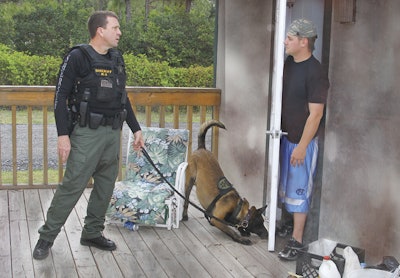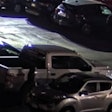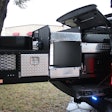 Photo by John Johnston, Ace K9.
Photo by John Johnston, Ace K9.
First, the good news.
Florida v. Harris
Clayton Harris was driving his truck in Liberty County, Florida, with expired license plates. A sheriff's deputy stopped him and, during the normal duration of the traffic stop, brought out a K-9 named "Aldo" and walked him around the outside of the truck. Aldo alerted to the door handle on the driver's side. In a search of the truck, the deputy found 200 pseudoephedrine pills and other methamphetamine precursors.
Harris was arrested and charged with possession of chemicals with intent to manufacture narcotics. After his suppression motion was denied by the trial court, he pleaded guilty, while reserving the right to appeal the denial of his suppression motion.
The Florida Supreme Court ruled that the suppression motion should have been granted. That court created a rigid set of requirements that a dog and handler would have to meet to support a finding of probable cause, including exhaustive training and certification records, field performance records, and records on how often the dog alerted without any drugs being found. The state appealed this decision to the U.S. Supreme Court, which unanimously reversed.
The court first pointed out that the "probable cause" determination is not supposed to be reduced to a rigid set of rules, but is to be a common sense evaluation of all the circumstances, to consider whether the facts show a "fair probability" that a search will reveal contraband. The high court criticized the approach taken by the Florida Supreme Court, saying the following:
"We have rejected rigid rules, bright-line tests, and mechanistic inquiries in favor of a more flexible, all-things-considered approach. The Florida Supreme Court flouted this established approach to determining probable cause. To assess the reliability of a drug-detection dog, the court created a strict evidentiary checklist, whose every item the State must tick off. That is the antithesis of a totality-of-the-circumstances analysis. No more for dogs than for human informants is such an inflexible checklist the way to prove reliability, and thus establish probable cause."
The Supreme Court noted that no purpose would be served in collecting and reporting evidence of a dog's "false hits," because that might only mean the drugs were so well hidden that officers failed to find them, or that the dog was alerting to the residual scent of drugs that had recently been removed. And the court said that no specific list of training certifications could be required for a finding of probable cause. Said the court,
"If a bona fide organization has certified a dog after testing his reliability in a controlled setting, a court can presume (subject to any conflicting evidence offered) that the dog's alert provides probable cause to search. The same is true, even in the absence of formal certification, if the dog has recently and successfully completed a training program that evaluated his proficiency in locating drugs."
The Supreme Court said that K-9 evidence should be evaluated by the same probable-cause standards as other forms of proof: "The question—similar to every inquiry into probable cause—is whether all the facts surrounding a dog's alert, viewed through the lens of common sense, would make a reasonably prudent person think that a search would reveal contraband or evidence of a crime. A sniff is up to snuff when it meets that test."
When the Supreme Court applied this test to the evidence of Aldo's performance, it reached this conclusion: "Because training records established Aldo's reliability in detecting drugs and Harris failed to undermine that showing, we agree with the trial court that the deputy had probable cause to search Harris's truck."
Now, the bad news.
Florida v. Jardines
Narcotics officers in Miami-Dade had a tip that Joelis Jardines was growing marijuana in his house. They had no corroborating information sufficient to get a search warrant, so they took a drug-detector dog up the driveway and onto the front porch. After a minute or two of sniffing around, the dog alerted at the front door. The officers used the evidence of the K-9 hit to obtain a warrant, under which they found and confiscated marijuana plants.
Jardines was charged with trafficking in cannabis (and stealing the electricity that powered his grow operation). He moved to suppress the evidence obtained under the warrant, on the ground that the K-9 sniff was an unlawful search that tainted the PC in the affidavit. When the case reached the U.S. Supreme Court, a five-member majority of the justices agreed with Jardines and ordered the warrant quashed and the evidence suppressed.
As I've previously pointed out in this space (see POLICE, March and December 2012), the new, alternative definition of "search" created by U.S. v. Jones has far-reaching implications for many other investigative practices, in addition to GPS tracking. In Jardines, the court majority applied this newer definition to find that officers violated the Fourth Amendment by bringing a drug-sniffing dog onto the curtilage of Jardines' home.
Although the court agreed that it is commonly accepted that visitors (including police) have an implied license to approach the front door of a residence, the scope of that license does not allow what officers did in this case. Said the court,
"The scope of a license—express or implied—is limited not only to a particular area but also to a particular purpose. Here, the background social norms that invite a visitor to the front door do not invite him there to conduct a search. The government's use of trained police dogs to investigate the home and its immediate surroundings is a 'search' within the meaning of the Fourth Amendment."
The court was careful to note that this decision does not invalidate the "knock-and-talk" practice of seeking an interview at the suspect's doorway. The opinion states, "A police officer not armed with a warrant may approach a home and knock. The mere purpose of obtaining information in the course of that permitted conduct does not violate the Fourth Amendment."
Although the ruling does not say so, it will still arguably be permissible to use a K-9 within the curtilage without a warrant when attempting rescues, tracking dangerous fugitives, and searching for explosives, since those "searches" would be justified by exigent circumstances.
K-9 Summary
The Supreme Court has decided five K-9 cases, with the following operable rules:
- A non-trespassory dog sniff is not itself a search. (U.S. v. Place)
- Vehicles may not be stopped at a highway checkpoint just to allow a K-9 sniff for drugs. (Indianapolis v. Edmond)
- At a lawful traffic stop, a K-9 can be walked around the vehicle to check for drugs. (Illinois v. Caballes)
- An alert from a reliable K-9 is PC to search a lawfully stopped vehicle for drugs. (Florida v. Harris)
- Bringing a K-9 onto the residential curtilage to sniff for drugs is a search, requiring either a warrant or some exception. (Florida v. Jardines)
Devallis Rutledge is a former police officer and veteran prosecutor who currently serves as special counsel to the Los Angeles County district attorney. He is the author of 12 books, including "Investigative Constitutional Law."


















